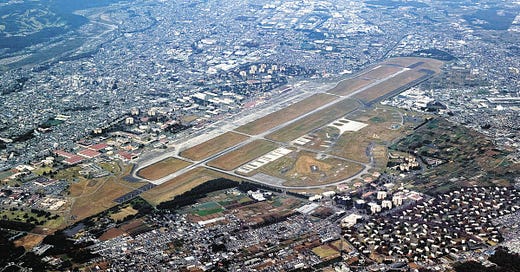Overview of U.S. Military in Japan: U.S. Military and Modern Colonialism #2
As I explained in the article Overview of U.S. Imperialism, in foreign countries, Japan has the most U.S. military in its territory.
Legal Basis
The U.S. military deploys in Japan on the legal basis of the Treaty of Mutual Cooperation and Security between Japan and the United States of America (Japan-U.S. Security Treaty), which was concluded in 1951 and revised in 1960; Article 6 provides that "the United States of America is granted the use by its land, air and naval forces of facilities and areas in Japan."
Also, if the U.S. and Japan agree at the Joint Committee, the U.S. military can use the sites Japan operates, which means Japanese Self‐Defense Forces (JSDF) bases, stations, etc.
Agreement under Article VI of the Japan-U.S. Security Treaty, Regarding Facilities and Areas and the Status of United States Armed Forces in Japan (U.S.-Japan Status of Forces Agreement, SOFA), Ariticle2, paragraph 1(b) states that "With respect to facilities and areas which are to be used by United States armed forces for limited periods of time, the Joint Committee shall specify in the agreements covering such facilities and areas the extent to which the provisions of this Agreement shall apply."
The Number of U.S. military Installations
The Japanese Ministry of Defense publishes data on the U.S. military installations in Japan.
According to it, as of January 1, 2024, Japan has 76 U.S. military installations, including camps, bases, naval ports, maneuvering ranges, docks, powder magazines, fuel terminals, depots, housing, communications sites, a press center, etc. The U.S. operates these installations, but some are used jointly by the U.S. and Japan.
Table 1 illustrates the number of U.S. military installations in Japan by prefecture. The total number doesn't match because of a few installations on the border of prefectures.
I painted the prefectures where the 1-5 U.S. military installations are Light Pink, 6-15 Red, and over 15 Yellow.
According to the Japanese Ministry of Defense, there are 130 U.S. military installations, including Japanese facilities and areas used by the U.S. military.
Table 2 shows the number of U.S. military installations and Japanese Self‐Defense Forces (JSDF) bases the U.S. military uses by prefecture. The total number doesn't match because of a few installations on the border of prefectures.
I painted the prefecture 1-5 U.S. military sites and JSDF bases where the U.S. military uses Gray, 6-10 Light Blue, 11-15 Light Pink, 16-20 Red, and over 20 yellow.
Area of U.S. military installations
The total area of the U.S. military installation in Japan is 26263 hectares (262.63 square kilometers).
Table 3 displays the number of hectares the U.S. military installations occupy in Japan by prefecture.
I painted the prefectures U.S. military installations occupy under 10 hectares Light Blue, 10-999 Light Pink, 1,000-5,000 Red, and over 5,000 Yellow.
The total area of U.S. military installations in Japan, including the Japanese facilities and areas used by the U.S. military, is approximately 98013 hectares (980.13 square kilometers).
Table 4 shows the proportion of the area of the U.S. military installations by prefecture.
The Number of U.S. Personnel
The U.S. deploys its active-duty, National Guard, National Reserve, and DoD Appropriated Fund (APF) civilian personnel overseas.
The tables show the number of U.S. personnel stations in Japan.
I referred to the table Number of Military and DoD Appropriated Fund (APF) Civilian Personnel Dec.2023, published by the Defense Manpower Data Center (DMDC). The data is the latest as of this writing.
It only represents the unclassified data on personnel assigned for duty.
The table also includes personnel assigned to the Embassies overseas. It does not include all personnel on temporary duty.
According to Defense Primer: DOD Appropriated Fund Civilians, published by the Congressional Research Service, "DOD civilians provide direct and indirect support to the warfighter across numerous disciplines, such as engineering, supply management, information technology, cybersecurity, intelligence, financial management, and law. For example, some civilians directly support military operations by training, advising, and assisting military personnel from other nations to build defense capacity in ground logistics, cybersecurity, and combat readiness. Other civilians help procure, build, test, or maintain major weapons systems used by military personnel in operations."
Conclusion
Approximately 70% of U.S. military installations in Japan are concentrated in Okinawa and occupy 8% of the prefecture and 15% of the main island of Okinawa.
However, not only Okinawa but also the U.S. military deploys all over the country, and approximately 12% of the U.S. military installations are located in the Tokyo metropolitan area.
In addition, Japan has provided vast training airspace and waters to the U.S. military.
Next time, I will describe the actual conditions of Japan in relation to the U.S. military.
Thank you for reading. If you enjoyed this piece, please share, subscribe, and support me. You can send a one-off payment safely from here using a credit card, Apple Pay, or Google Pay. Also, you can be a paid subscriber to my Substack.















